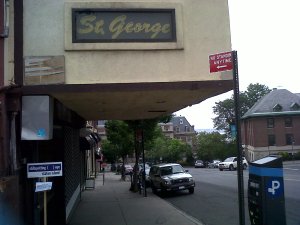The Guggenheim has been installing multimedia projects with a strong performance element throughout New York City for the last year and a half. This, their penultimate stillspotting event, took place in Staten Island’s waterfront. Poet Matthea Harvey and sound artist Justin Bennett worked together to create a sound-text to accompany a two hour walk (give or take) along the Staten Island waterfront facing Manhattan and Brooklyn.
The sound-text is a lyrical interpretation of inventor Antonio Meucci’s life as an inventor and the relationship he maintained with his wife, Estera, an opera singer. Meucci, in addtion to coming up with water metronomes, glass pianos, new ways to pasteurize milk (see Matthea Harvey’s embroiderings below), also created the first design for a telephone, called the telettrofono (the name of this exhibit).
As you might guess given the waterfront, everything about this version of Meucci and Estera’s story is nautical, even the phone (made of mollusks we’re told). Our curiosity is piqued to consider the nature of sound as waves and the nature of waves as sound. What better place to do this than a waterfront?
Given the map, a headset, and gentle shove from the site hosts, you start to wonder what pieces you see are by chance (real) or have been planted (representation). In one moment someone that looks just like the description of Estera goes by on a bike. Others use the landscape, in this case the glass piano, to create new, imaginative story-lines.
On the other hand, there’s an element of “found” in the exhibit. At the beginning of the tour it’s not clear what is part of the exhibit. You begin to wonder if the people that day enjoying the waterfront are plants. Do they have anything to do with what is being said? The same goes for the garbage, which sadly is still on this waterfront. Now and then it seemed as though the debris was part of the exhibit and in some cases it was.
Thinking back to doing this last weekend, the whole thing about sound, waves, sea, and mermaids reminds me of the Wallace Stevens’ poem “The Idea of Order at Key West” – which by the way you can sing to the tune of “Come On Baby Light My Fire”. (Go give it a try.)
Unbeknownst to Matthea and Justin however, someone had already set a soundtrack to this particular waterfront. Their soundtrack was radically different.
(By the way, the salt depot we entered, as well as the water surrounding it was, in the Wu-Tang Clan video, “Method Man” (the B-side on the vinyl single of “Protect Ya Neck”))
I had never experienced anything like this before. This was an exciting way to employ a narrative. We were never in isolation at any moment. There was a community aspect to the audio tour as well. Neighbors stopped and asked us what we were doing, or where did “it” begin. This was much better than making a museum invisible: Just get rid of the building all together!










You must be logged in to post a comment.